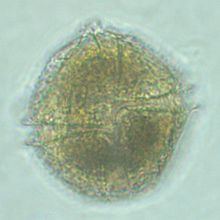Lingulodinium polyedra
Lingulodinium polyedra is a mobile photosynthetic dinoflagellate. It gives off a bioluminescent light which shows on beaches at night. It causes red tides.



L. polyedra causes red tides in southern California, with bioluminescent displays on beaches at night.
The organism was first described in 1955 as a cyst, Hystrichosphaeridium machaerophorum from the Miocene of Balcombe Bay, Victoria, Australia.[1] Its first appearance in the fossil record was in the Palaeocene.
The toxins from such tiny dinoflagellates accumulate in shellfish which feed on them. Mussels, scallops and clams can be the agents of food poisoning if they eat these dinoflagellates.[2]
Keeping live shellfish in pure water for three days before cooking is a standard way to avoid this problem.